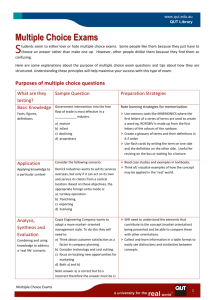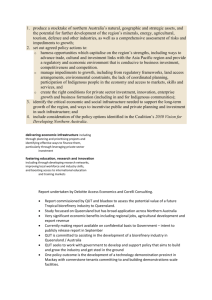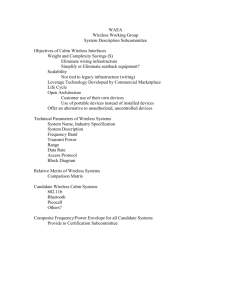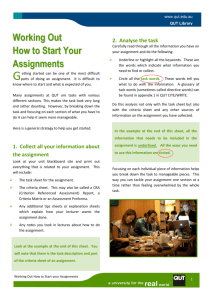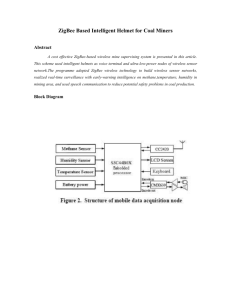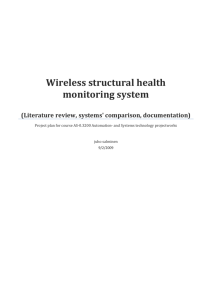wireless Policy - IT Services
advertisement
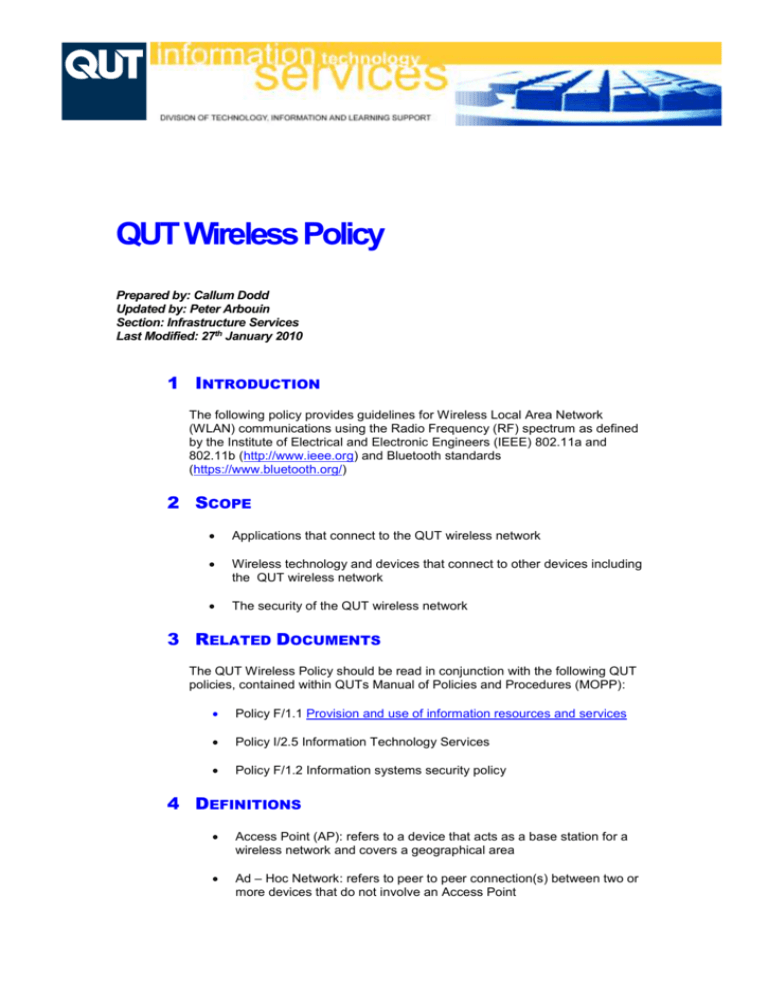
QUT Wireless Policy Prepared by: Callum Dodd Updated by: Peter Arbouin Section: Infrastructure Services Last Modified: 27th January 2010 1 INTRODUCTION The following policy provides guidelines for Wireless Local Area Network (WLAN) communications using the Radio Frequency (RF) spectrum as defined by the Institute of Electrical and Electronic Engineers (IEEE) 802.11a and 802.11b (http://www.ieee.org) and Bluetooth standards (https://www.bluetooth.org/) 2 SCOPE Applications that connect to the QUT wireless network Wireless technology and devices that connect to other devices including the QUT wireless network The security of the QUT wireless network 3 RELATED DOCUMENTS The QUT Wireless Policy should be read in conjunction with the following QUT policies, contained within QUTs Manual of Policies and Procedures (MOPP): Policy F/1.1 Provision and use of information resources and services Policy I/2.5 Information Technology Services Policy F/1.2 Information systems security policy 4 DEFINITIONS Access Point (AP): refers to a device that acts as a base station for a wireless network and covers a geographical area Ad – Hoc Network: refers to peer to peer connection(s) between two or more devices that do not involve an Access Point QUT W IRELESS POLICY Interference: refers to the degradation of wireless communication caused by electro-magnetic radiation from another source Wireless Research Networks: refers to wireless networks assisting in the research of wireless technology, or the delivery of educational material using wireless technology as a transport medium. Users on these networks are not capable of accessing any QUT applications and/or resources. Highly Protected: QUT has defined the term Highly Protected under the F/1.2 Information systems security policy in the MOPP (refer to http://www.mopp.qut.edu.au/F/F_01_02.jsp) 5 GUIDELINES By accepting this policy users of the QUT wireless network acknowledge that the wireless network is a potential security risk, that QUT has investigated this issue, and has developed a network architecture that balances security and ease of use; the issues of security and useability are important to QUT. Wireless networks broadcast information indiscriminately. QUT suggests that any information that the user considers sensitive, or that QUT considers to be “Highly Protected”, not be transmitted over the QUT wireless network The QUT wireless network has certain limitations over the QUT wired network. The QUT wireless network should be considered to complement the QUT wired network by extending its reach and allowing some mobility. Applications producing high levels of data traffic across the wireless network may not be appropriate for wireless access as it may have a detrimental effect on the quality of the network for all users All Client devices and wireless network devices must conform to the appropriate Australian Communications and Media Authority (ACMA) regulations (Website: http://www.acma.gov.au/) All client devices accessing the QUT wireless network must be Wi-Fi Certified™ (http://www.wi-fi.org) All client devices accessing the QUT wireless network must support one or more of the following IEEE Standards: o 802.11a o 802.11b o 802.11g o 802.11n Note: There is a preference for client devices to support 802.11n 5 Ghz Client devices should be capable of connecting to the QUT wireless network using one of the secure access methods. Information relating to these can be located at the On Campus Access web page (http://www.wireless.qut.edu.au) 2 QUT W IRELESS POLICY QUT will provide documentation on the methodology of connecting to QUT’s Wireless network for, at a minimum, the operating systems that QUT supports. All users must authenticate before gaining access to QUT content and applications when using the QUT wireless network Authentication must be encrypted in accordance with encryption standards deemed acceptable by Information Technology Services (ITS). All encrypted methods must be approved by IT Services. These methods are outlined in the restricted section of the On Campus Access web page (http://www.wireless.qut.edu.au) All data transmissions must be encrypted between the client’s device and the QUT wireless network The Ad-Hoc feature should be disabled on all client devices and client cards With the exception of wireless research activities, the only permitted wireless access points are those managed by Information Technology Services. Applications for exemptions must be made to the Director, Information Technology Services. Applications for exemptions should include: o o o o Name of QUT organisational unit that is applying for the exemption Information specifically on the wireless network detailing: What the wireless network is attempting to achieve What information will be transmitted across the network What security will be in place to protect the network What will be the coverage area What frequency(ies) will be used What activities will be conducted to avoid interference with the QUT wireless network During what period(s) the research network will be activated. This must include dates and time of day. QUT may seek disciplinary action against the person(s) responsible in accordance with the Statutes of the Queensland University of Technology (MOPP Appendix 1(b)) or the Queensland University of Technology Information Facilities Rules (MOPP Appendix 1(c)). This is applicable for the following breaches: o Interference, disruption or interception of the QUT wireless network signals is considered a violation of this policy, except for diagnostic purposes by IT Services. Any wireless network device, including Wireless Research Networks, causing service interruption to any QUT network will be shut down. o Non-authorised access points will be considered to be in breach of QUT’s IF Rules, and QUT may seek disciplinary action against the person(s) responsible IT Services will manage and support all authorised wireless networks, with the exception of Wireless Research Networks 3 QUT W IRELESS POLICY Any research activities or authorised wireless network not managed by IT Services must conform to the principles of this policy if the wireless network is capable of accessing QUT information facilities. Any conflicts with channel allocation will be resolved by IT Services Risk assessment is to be conducted in accordance with procedures listed in the Wireless Networks Procedures document, at intervals not exceeding 12 months. QUT campuses may have their radio frequency spectrum scanned at least once a month, at the discretion of IT Services. The frequencies scanned will be those defined by the IEEE 802.11a and 802.11b (http://www.ieee.org) standards. This will be conducted by a representative of IT Services This policy will be reviewed as necessary but at least every 2 years 6 MODIFICATION HISTORY Updated links to acma Updated link to MOPP Added support for 802.11n Removed this as we do not maintain a list of supported clients: QUT will provide and maintain a recommended list of client devices and wireless network interface cards that are known to operate successfully with the QUT wireless network. This information is available on the On Campus Access web page (http://www.wireless.qut.edu.au) 4
